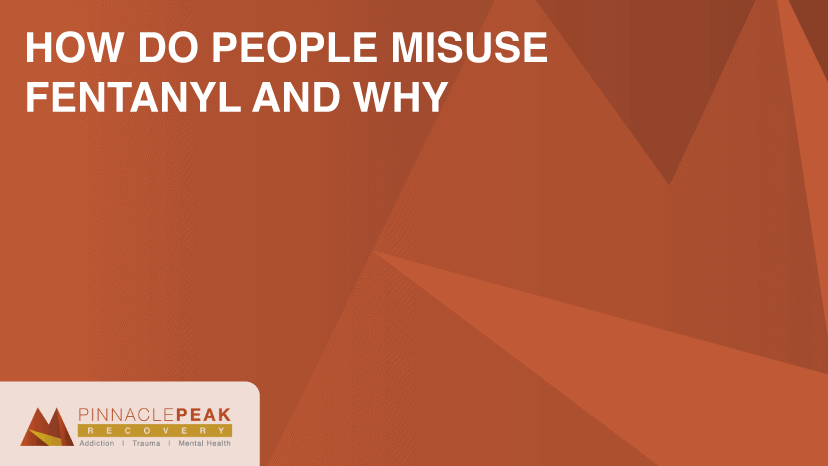Fentanyl Side Effects

Fentanyl is one of the leading causes of overdose in the United States. In Arizona, teenagers as young as 14 have taken this substance and died from its effects. The good news is treatment for fentanyl addiction is available and effective. Understanding the side effects of fentanyl use is valuable for anyone seeking recovery or supporting a loved one in their recovery journey.
What is Fentanyl Prescribed For?
Fentanyl was originally developed as a medication for chronic severe pain or for temporary use by individuals recovering from surgery. Fentanyl is an opioid. Another example of an opioid is morphine, but fentanyl is 80-100 times more potent than morphine. Therefore, a healthcare professional should monitor all fentanyl use to ensure appropriate dosage.
What Are Some Side Effects of Fentanyl?
Long-term fentanyl use effects
Fentanyl use over a long period is likely to produce effects such as:
- Constipation
- Unstable mood
- Reduced libido
- Respiratory problems
- Menstrual problems
Short-term fentanyl use effects
A person who is new to fentanyl use can expect to experience the following effects:
- Vomiting
- Pain relief
- Nausea
- Euphoria Diarrhea
- Constipation
- Fatigue
- Reduced appetite
- Cramps
- Confusion
- Drowsiness
- Indigestion
- Weakness
- Headaches
- Difficulty speaking
- Low blood pressure
- Rash
Common Side Effects
A person’s weight, size, health, duration of fentanyl use, presence of other substance use, amount taken, and strength of the fentanyl used are all factors that determine the effect of fentanyl on a person. Some effects can vary from person to person. Side effects that tend to be more common are:
- Irregular heartbeat
- Lightheadedness
- Tiredness
- Muscle stiffness
- Blue lips, fingernails, and skin
Rare Side Effects
Some of the more uncommon fentanyl side effects include:
- Vomiting
- Bleeding
- Burning sensation
- Welts
- Redness of skin
How Does Fentanyl Affect the Body?
Fentanyl causes a person to feel euphoric effects and decreases feelings of pain. These properties make fentanyl an effective treatment for intense or chronic pain. Fentanyl is significantly more potent than other opioid medications, and the potential for misuse is high. This is why fentanyl should be used only under the supervision of a doctor. Reduction in respiratory function is a potentially dangerous effect of fentanyl use. Hypoxia, a condition where the brain is not receiving enough oxygen, can result from this reduction in respiratory function. Hypoxia can sometimes lead to coma, permanent brain damage, and death. Blue lips, fingernails, or skin are signs that a person using fentanyl may need medical attention due to a lack of oxygen.
How Does Fentanyl Affect the Brain?
Fentanyl and other opioids bind to a person’s opioid receptors. Opioid receptors reside in a person’s brain and control pain and emotion. When a person takes fentanyl, the brain gradually adjusts to the presence of fentanyl. This causes a person to develop a tolerance, meaning they will need to increase their fentanyl dosage to feel the same effects. This can lead to severe consequences such as overdose due to the increased dosage. It can also lead to a person developing an opioid use disorder, which can lead to someone prioritizing fentanyl use above other vital aspects of their life.
Fentanyl Hallucinations
Around 6 percent of patients who use prescription fentanyl report experiencing hallucinations. This number may be inaccurate due to the stigma associated with reporting a hallucination. Hallucinations due to illicit fentanyl use are also infrequent and not often reported. If someone is experiencing a fentanyl-induced hallucination, the medication naloxone will end the hallucination. Naloxone is a medication designed to end the effects of fentanyl use. It prevents fentanyl and other opioids from bonding with a person’s opioid receptors.
The Danger of Potential Overdose
The United States Drug Enforcement Administration reports that fentanyl and other synthetic opioids cause the highest percentage of overdose deaths. Between 2020 and 2021, overdose deaths involving fentanyl and other synthetic opioids increased by 55.6 percent. This is partly because fentanyl is often combined with other substances to make them more potent. It’s also due to the need of those manufacturing and selling illicit substances to increase their profits. Arizona recently legalized the use of fentanyl test strips. These strips can indicate if a substance has fentanyl in it with a chemical reaction inside the strip. This is the only accessible way to know if fentanyl is in a substance purchased illicitly.
How to Cope With the Side Effects of Fentanyl
Naloxone is available at pharmacies in Arizona. This medication will reverse the effects of fentanyl by blocking its effects on the brain’s opioid receptors.
If you suspect that someone is overdosing on fentanyl, call 911 immediately. If it is available, you should administer naloxone as soon as possible. Naloxone will not harm someone who has not taken opioids, so do not worry about causing harm. Wait with the person who is overdosing and help them stay awake until professional help arrives.
Treatment for Fentanyl Addiction
Fentanyl addiction can be challenging to overcome, but with help, recovery is possible. Pinnacle Peak Recovery Center has individualized treatment plans to help people achieve their recovery goals.
No one needs to suffer from opioid use disorder alone. Contact Pinnacle Peak Recovery Center at 866-377-4761 to learn more about quality treatment options that can lead you or your loved one to recovery.
FAQs About the Side Effects of Fentanyl
What are the significant side effects of fentanyl?
When a person takes fentanyl, they experience euphoria and a significant decrease in pain. It is also common to experience a reduction in respiration, tiredness, sore muscles, and blueness in a person’s lips or fingertips.
How long does fentanyl take to affect the body?
It typically takes 15 minutes for fentanyl to start affecting a person’s body. However, the effects of fentanyl can vary depending on a person’s size, overall health, and how long they have been using fentanyl.How do you treat the side effects of fentanyl?
The best way to treat the side effects of fentanyl is to use naloxone, a medication designed to end the effects of fentanyl use.



